2. Construction and outfit and characteristics
2.1 Construction and outfit of fast rescue boats
Flat Bottom: Although this hull type has good initial stability in calm weather it, because of its flatter bow and hard chine, provides a comparatively rougher ride. This is typically a planing boat that rides on top of rather than through the water. Due to its roughness at speed these hulls are limited to the amount of horsepower applied.
Partial “V”: The V allows the boat a softer ride to minimize slapping and provide some grip in turns. Although a smoother ride is achieved the deeper or more deadrise a hull has the more wetted surface is increased and also resistance.
Deep “V”: are usually hulls that require good stability and are commonly flattened at the stern which allows for planing at high speeds.
Round Bottom: This shape of hull almost always refers to displacement hulls. Sailboat hulls are usually of this type. The round at the bilge or near the waterline helps reduce wetted surface area and usually allows for good reserve stability.
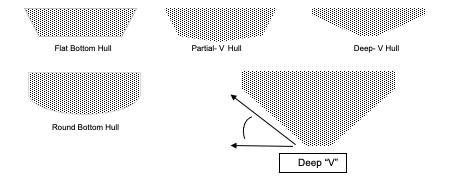
Dead Rise Angle: Is the angle measured from the bottom of the Keel. This hull angle is said to be a deep “V”. A Flat bottom boat has 0º Rise, while a racing boat may have a 50º Rise.
Strake Pads and Sponsons
Strakes: are commonly referred to as rubbing strakes, which are on ships and boats alike. They are sacrificial parts of the hull or Sponsons that protrude from the hull which rub against the dock or alongside vessels which minimize wear. They run fore and aft on the outer sides and are made from wood, steel, or reinforced rubber.
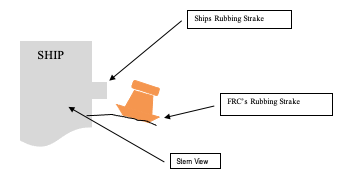
Pads: are reinforced rubber patches that are located where becketed lines run, or extra support for towing patches.
Sponsons: Are usually inflatable tubes that are separated by inner chambers, that give the vessel added buoyancy and cushioning. Sponsons are designed so if one chamber gets punctured, a bladder is sent to the punctured side to give the boat some rigidity. The hull characteristic of a boat determines whether a boat is fast or slow, how well it will handle and how stable it is. Lifeboats are usually termed displacement, while Fast Rescue Boats need to be semi displacing and have an ability to plane. With different hull forms, come different handling characteristics. The performance of the hull is in direct proportion to the power.
- Deep “V” hulls are less likely to capsize but require more power to plane.
- Flat Bottom Boats are rough and have a low freeboard.
- Rigid Hulls are more likely to see damage when going alongside.
- Semi-Rigid Hulls have good cushioning but require constant maintenance on the Sponsons.
- Inflatable Boats have very soft impact but have limited space and high maintenance on their Sponsons.
Three types of Fast Rescue Boats
Inflatable Boats – which are boats which have inflatable Sponsons and rigid frame work on the deck. The Sponsons require inflation to remain afloat. This has to remain in state of readiness at all times.
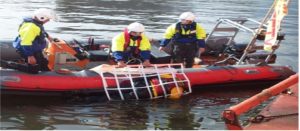
The buoyancy of an inflated rescue boat shall be provided by either a single tube subdivided into at least five separate compartments of approximately equal volume or two separate tubes neither exceeding 60% of the total volume.[1] Sponsons on FRB’s usually are inflated to 3-3.5 psi.
Basic Construction: The sponson material is made up of a ‘sandwich’ construction comprising a Nylon 66 weave, impregnated, and coated on both sides with Hypalon. The Hypalon coating is very tough and is resistant to ultra-violet radiation, ozone, petrol and oil. The sponson gives the lifeboat its overall length and beam when it is fixed to the rigid hull and inflated to the correct pressure. A rubber fender is fitted to the outer edges of the bow and side of the sponson to help protect the sponson side walls.
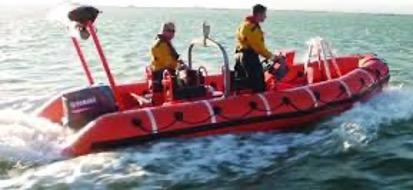
Semi inflatables – are boats which can still remain afloat without inflation in their Sponsons. The hull is made from reinforced plastic or fiber glass which is foam filled. Sponsons require inflation. This must remain in state of readiness at all times.
Rigid boats – Buoyancy is placed in the Plastic or fiber glass hull and have foam or rubber for rubbing strakes. Foam filled rubbing strakes have a better impact quality when coming alongside. This must remain in state of readiness at all times.
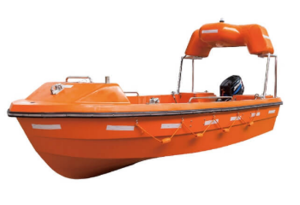
SOLAS-section 5, reg 47,1-1.5
- Fast Rescue boats must be not less than 3.8 m in length, and not longer than 8.5 m.
- Be capable of carrying at least 5 seated persons and a person lying down
Must be capable of manoeuvring at speeds up to 20 knots and maintaining that speed for a period of at least 4 hours.
Markings on the Fast Rescue Boat
- Manufacturers Name
- Boat #
- Month / year of Build
- Size L x B x H
- Approval Number
- Version- Jet
- Max weight
- Total capacity
Marking’s on the lifting hook:[2]
- Hook Manufacturer
- Type: Off load SWL
- Serial Number
- Month and year
- Markings on the Boat shall have:
- Number of persons for which the rescue boat is approved;
- Ship’s name;
- Port of registry;
- Positions for launching crew marked for Launch and Recovery
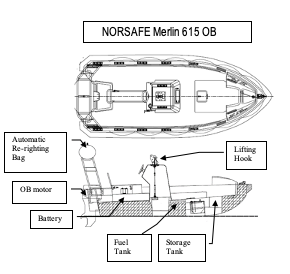
2.2 Individual items of equipment
Personal Protective Equipment
PFD- Personal Floatation Device gives between 15lb-35lbs of buoyancy to a crewmember with little to no thermal protection. They come in a variety of colors and sizes and are comfortable for the wearer. But will not ensure an unconscious casualty will remain face up while wearing this in the water, however certain manufacturers put out some inflatable versions that will.
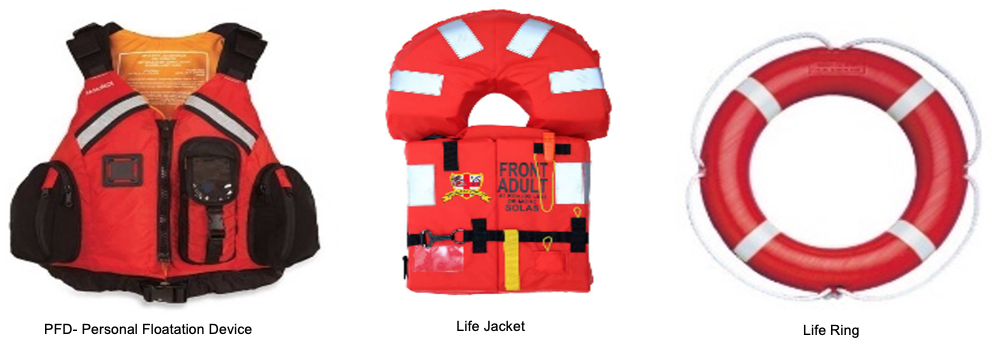
Life Jacket: has a minimum of 35lbs of buoyancy and will make an unconscious casualty remain face up. They come in colors such as International Orange, Red, and Yellow.
Lifebuoy: is a requirement for all vessels to have them on board, how many will be determined by the class and trade the vessel is engaged in. They have becketed of grab lines on the outer side of this ring for arm, handholds.
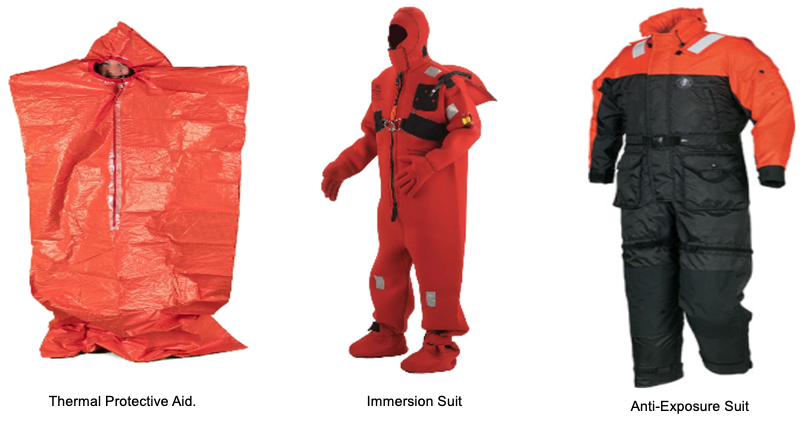
TPA-Thermal Protective Aid: is required in all rescue boats and lifeboats. It provides a quick means for thermal retention of the Hypothermic victim. Immersion Suit: Provides the wearer with a thermal protection that can maintain the body core temperature for long periods of time, while giving adequate flotation but limited mobility.
Anti-Exposure Suit: Provides a limited amount of thermal protection, excellent mobility with good flotation.
Handling and Maintenance of personal life saving appliances
NOTE: It is the responsibility of the crew members of the boat to make sure all gear is kept in good working order such as:
- All suits should be hosed down with fresh water after use.
- All zippers slide freely up and down (Manufacturers recommendations) usually
- bee’s wax.
- All reflective tape is legible.
- Velrefro straps and draw strings are working properly.
- Whistles are affixed to the suits.
- Locater lights kept in date.
- Helmets show no signs of damage.
- Report any deficiencies to Supervisor.
2.3 Characteristics of a fast rescue boat
Displacement modes can be divided into 2 categories:
- Displacement Mode: which means the underwater portion of the hull is displacing water which has a predetermined Hull speed.

- Planing Hull: The vessel rises out of the water from increasing speed which means the jet intake is the only thing in the water and the hull is planing on the surface, or in the case of outboards the propellor is the only thing in the water and the hull is planing on the surface.

Aeration and Cavitation
Aeration is usually associated with Impellors in Jet drives which happens when the sea intake grabs air with the water forming bubbles in the pump. This situation will cause the boat to have limited steering and maneuvering control. The engine will rev excessively at high RPM’s and not respond to steering or braking. This commonly happens when going astern.
Cavitation: Often mistaken for aeration or ventilation, cavitation is a disturbance of water flow to the face of the propeller blade or blades. When it happens, you’ll feel excess vibration. Physically, cavitation occurs when low-pressure bubbles form on the blade surface, which can generate enough heat to burn the face of the propeller blade.
Towing arrangements[3]
Towing arrangements on FRC’s depend on the design they can be located on a Tow Post or may have cleats made for Bridals located on each side of the “A” Frame.
Davits: Davit manufacturers around the world are always testing and dealing with industry requirements for life saving and efficiency, here is a few of the more common type of Davit systems.
Miranda Davit Schat Harding: The Miranda is a very heavy structure and the control mechanism entailed having a sub-frame that was lowered with the boat attached down to the water. This sub-frame ran on rollers down the davit and the ship’s side; the FRC was hooked onto the frame rather than the davit hoist and it was thus pinned against the frame during launch and recovery. Having this frame alongside the ship during recovery means that the recovery operation has to be carried out with the ship either stopped or moving ahead very slowly. Some davits have a painter for the cradle and one for FRB. Others launch with the sea with no painters.
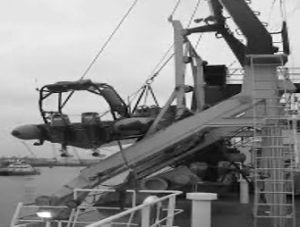
G-Davit- Hydra marine: Hydra marine davits are probably the most widely used in the North Sea and whilst they offer the normal G-davit they have also developed some novel systems including a low profile partially pivoting, partially slewing davit. In standard form the Hydra marine davits have the hoist winch mounted on the davit frame and a shock absorbing system on the hoist wire and the davits are offered with the option of constant tension and a docking head for controlling the motion of the FRC. Versions of the Hydra marine davits are available with sliding or fixed hooks that help to locate the FRC during the early stages of launch so that it movement is controlled up till the point where it can be located against the ship’s side.
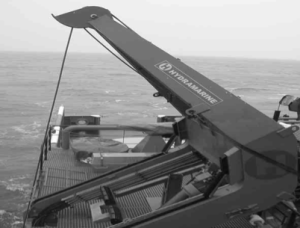
Crane Launch and recovery system: Using a deck crane for launch and recovery offers advantages in that the crane is a versatile piece of equipment that can be used for other purposes such as survivor recovery in addition to the launch and recovery of the FRC. It can provide a cheaper alternative than dedicated davits because a crane is usually fitted to the ship anyway for handling equipment and stores and one crane could be used to launch FRCs on both sides of the vessel.
When using a deck crane for launch and recovery the boat is handled in a similar way as when operating a davit once the FRC is over the ship’s side. It is when the FRC is being transferred from its deck stowage to a position over the side ready for launching that the FRC can be at risk from damage. Here the FRC can be subject to both rotation and the pendulum effect on the end of the crane hoist. The FRC can be located by using hand-held ropes provided that it a relatively light and small craft but this increases the man-power requirements for launch and recovery and the weight of a larger craft could make it difficult to control it if the ship motions are large.
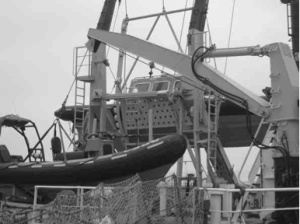
Caley Davit: Caley only produces larger davits incorporating constant tension and a docking head that are mainly designed for daughter craft. They were one of the pioneers in this sector.
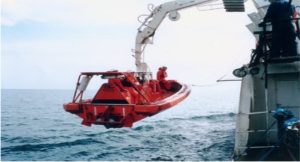
Vestdavit: Is another Norwegian davit manufacturer but the main focus of this manufacturer is on the supply of SOLAS and specialized davit systems. Their FRC davit is of the conventional G-type with the winch mounted on the davit frame and they do make larger davit systems with constant tension and docking head systems, and these are mainly used for daughter craft.
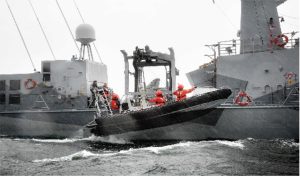
Sponson Repair
Sponsons are very durable but through rough abrasion or lack of maintenance there may be leaks. These leaks are commonly found around:
- Seams – These should only be repaired by the dealer or within 2” of a seam.
- Inflation valves or Pressure release valves.
- Punctures and punctures- Holes or tears over 1” long should be sent to the dealer.
Sponsons are made from different fabrics (for example Hypalon, GRP, PVC or PU) using different procedures (examples gluing and welding). When repairing you need to know the fabric used in making the inflatable boat, so that you know what glue you need to use (Manufacturers recommended). For the different materials and different glues, you then need to know what procedures are to be used. In most repairs of inflatable boats the procedures are most important. If you have all the correct materials and glues and you do not apply the correct procedure the repair will fail.

This procedure is with a deflated Sponson. Use manufacturers guidelines:
- Prepare the hole by roughing up the perimeter and then
- Cut 2 patches so they overlap by 2” on all sides
- Ensure area is dry
- Apply thin coat of glue with brush inside the hole and outside
- Apply glue to patch for the inside
- Glue should be dry to the touch, insert through the hole and press firmly
- Apply glue to the inside patch which is now glued on the inside wall and glue Tube to allow for the outside patch to adhere.
- Glue the outside patch when is dry to the touch and apply pressure to the patch.
- Re-inflate tube.
This is only one manufacturers repair kit. Use manufacturers guidelines of your RHIB
Image Credits
-
- Markus Lifenet. (2019). Man Overboard Recovery System, type SCN6-200 to 400 (p.4)[ Info sheet]. https://markusnet.com/wp-content/uploads/2019/07/LEI-079-4-SCN6-200-to-400R-FRC-Info-sheet.pdf
- Survite Group. (n.d.). RIBO 340 search and rescue boat. https://survitecgroup.com/media/342547/survitec_zodiac_rescue_boats_ribo.pdf
- TUF Marine. (2019). 4.5 meter fully rigid FRP GRP rescue boat. https://tufmarine.com/frp-rescue-boat/
- Viking Norsafe. (2017). Merlin-615 MKI, Outboard.
- Canoeing Company. (2019). Kokatat Bahia Tour PFD. https://www.backcountry.com/kokatat-bahia-tour-personal-flotation-device
- Global Industrial. (2023). Veleria San Giorgio VSMK10AM VSG Life Jacket. https://www.globalindustrial.ca/p/vl-san-giorgio-vsmk10am-vsg-life-jacket-solas-med-orange-adult-oversize?ref=
- Hansen Protection. (n.d.). Ascotherm Mk I: TPA-Thermal Protective Aid. https://hansenprotection.no/en/suits/thermal-protective-aids-tpa/Ascotherm-Mk-I.html
- Datrex Life Saving Products. (2021). Stearns Immersion Suits. https://www.datrex.com/product/stearns-universal-uscgsolasmed/
- Mustang Survival. 92021). Deluxe anti-exposure coverall. https://mustangsurvival.com/products/deluxe-anti-exposure-coverall-and-worksuit-ms2175)
- Health and Safety Executive. (2005). Improving the performance of rescue craft used for rescue and recovery in support
of the oil and gas industry. https://www.hse.gov.uk/research/rrpdf/rr371.pdf - Ibid
- Ibid
- Pryme Group Holdings. (2019). The Caley Davit. Caley Ocean Systems. https://caley.co.uk/davits/
- Vestdavit Production. (2023). Safe boat handling. https://www.vestdavit.no/
- Regulation#23 Rescue boats in International Maritime Organization. (2021). Regulations for the construction and equipment of fishing vessels. https://www.imorules.com/GUID-CFD93744-4BAA-4C9A-92F2-D223E93A9577.html ↵
- Code of Federal Regulations (2012). 46 CFR § 199.176 – Markings on lifesaving appliances. https://www.ecfr.gov/current/title-46/chapter-I/subchapter-W/part-199/subpart-B/section-199.176 ↵
- Images and text in Towing Arrangements section adapted from Health and Safety Executive. (2005). Improving the performance of rescue craft used for rescue and recovery in support of the oil and gas industry. https://www.hse.gov.uk/research/rrpdf/rr371.pdf ↵
